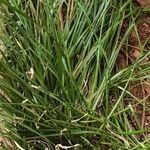Leaves almost terete at base to somewhat flattened towards obtuse tip, twisted, to 35 cm long, 2-4 mm wide. Scape c. 25 cm long and 1.5-4 mm wide; spathe scarious, c. 2.5 cm long, sheathing at base for c. 1 cm. Flower erect; pedicel c. 1.5 cm long. Perianth segments free, slightly spreading, ovate, 3-5 cm long, white; sepals slightly tinged with pink along abaxial median strip. Stamens equal; filaments inserted at base of perianth, 1-1.5 cm long; anthers 5-10 mm long. Style slightly declinate, slightly longer than stamens; stigma trilobed.
Bulbs ovoid, ca. 2.5 cm in diam., neck 2.5--5 cm. Leaves bright green, terete-linear, 20--30 cm × 2--4 mm, fleshy. Involucres red-brown. Flowers solitary, terminal; pedicel ca. 1 cm. Perianth white, often tinged with rose abaxially; lobes ± free, 3--5 × ca. 1 cm, usually with tiny scales near throat, apex obtuse to shortly acute. Stamens ca. 1/2 as long as perianth. Style slender; stigma 3-notched. Capsule subglobose, ca. 1.2 cm in diam. Fl. autumn.
Perigone about 1.5 cm long, white slightiy tinged with red.




